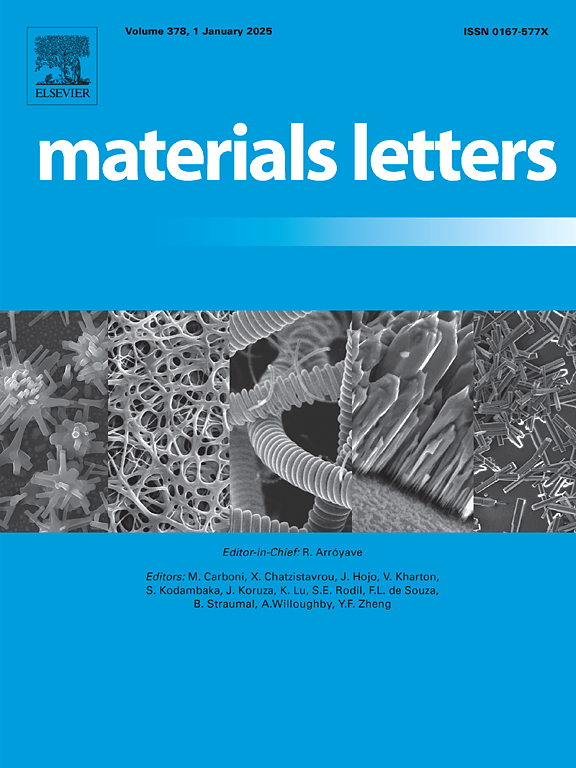Design and characterization of MXene@Ag nanoparticles-enhanced porous silk fibroin scaffolds for tissue engineering
IF 2.7
4区 材料科学
Q3 MATERIALS SCIENCE, MULTIDISCIPLINARY
引用次数: 0
Abstract
This study synthesized MXene@Ag hybrid nanoparticles via an in-situ reduction and incorporated them into regenerated silk fibroin (RSF) to fabricate a porous scaffold using freeze-drying. It showed that MXene@Ag enhances the regularity and density of the lamellar structures within the scaffold, while simultaneously reducing porosity (from 80.5 % to 66.5 %) and swelling rates (from 835 % to 649 %). MXene@Ag enhances β-sheet structures; however, excessive loading causes nanoparticle aggregation and a slight decrease in β-sheet content. Additionally, it improves both compressive strength (0.17–0.51 MPa) and modulus (0.26–3.51 MPa). Immersion in SBF for 14 days showed that MXene@Ag accelerates hydroxyapatite nucleation (Ca/P ≈ 1.8). Composite scaffolds with an MXene@Ag to RSF ratio below 1:100 demonstrated excellent biocompatibility and hemocompatibility. The antibacterial properties of the scaffolds were notably enhanced, even at low loading when exposed to red light (640–660 nm). It demonstrates the potential applications of RSF/MXene@Ag composite scaffolds in the biomedical field, particularly for bone tissue engineering.
MXene@Ag纳米颗粒增强多孔丝素蛋白组织工程支架的设计与表征
本研究通过原位还原法制备MXene@Ag杂化纳米颗粒,并将其掺入再生丝素(RSF)中冷冻干燥制备多孔支架。结果表明,MXene@Ag增强了支架内部层状结构的规整性和密度,同时降低了孔隙率(从80.5%降至66.5%)和膨胀率(从835%降至649%)。MXene@Ag增强β片结构;然而,过度负载会导致纳米颗粒聚集,并导致β片含量略有下降。同时提高了抗压强度(0.17 ~ 0.51 MPa)和模量(0.26 ~ 3.51 MPa)。在SBF中浸泡14 d, MXene@Ag加速羟基磷灰石成核(Ca/P≈1.8)。MXene@Ag与RSF比低于1:100的复合支架具有良好的生物相容性和血液相容性。在红光(640-660 nm)照射下,即使在低负荷下,支架的抗菌性能也明显增强。它展示了RSF/MXene@Ag复合支架在生物医学领域,特别是骨组织工程领域的潜在应用。
本文章由计算机程序翻译,如有差异,请以英文原文为准。
求助全文
约1分钟内获得全文
求助全文
来源期刊

Materials Letters
工程技术-材料科学:综合
CiteScore
5.60
自引率
3.30%
发文量
1948
审稿时长
50 days
期刊介绍:
Materials Letters has an open access mirror journal Materials Letters: X, sharing the same aims and scope, editorial team, submission system and rigorous peer review.
Materials Letters is dedicated to publishing novel, cutting edge reports of broad interest to the materials community. The journal provides a forum for materials scientists and engineers, physicists, and chemists to rapidly communicate on the most important topics in the field of materials.
Contributions include, but are not limited to, a variety of topics such as:
• Materials - Metals and alloys, amorphous solids, ceramics, composites, polymers, semiconductors
• Applications - Structural, opto-electronic, magnetic, medical, MEMS, sensors, smart
• Characterization - Analytical, microscopy, scanning probes, nanoscopic, optical, electrical, magnetic, acoustic, spectroscopic, diffraction
• Novel Materials - Micro and nanostructures (nanowires, nanotubes, nanoparticles), nanocomposites, thin films, superlattices, quantum dots.
• Processing - Crystal growth, thin film processing, sol-gel processing, mechanical processing, assembly, nanocrystalline processing.
• Properties - Mechanical, magnetic, optical, electrical, ferroelectric, thermal, interfacial, transport, thermodynamic
• Synthesis - Quenching, solid state, solidification, solution synthesis, vapor deposition, high pressure, explosive
 求助内容:
求助内容: 应助结果提醒方式:
应助结果提醒方式:


